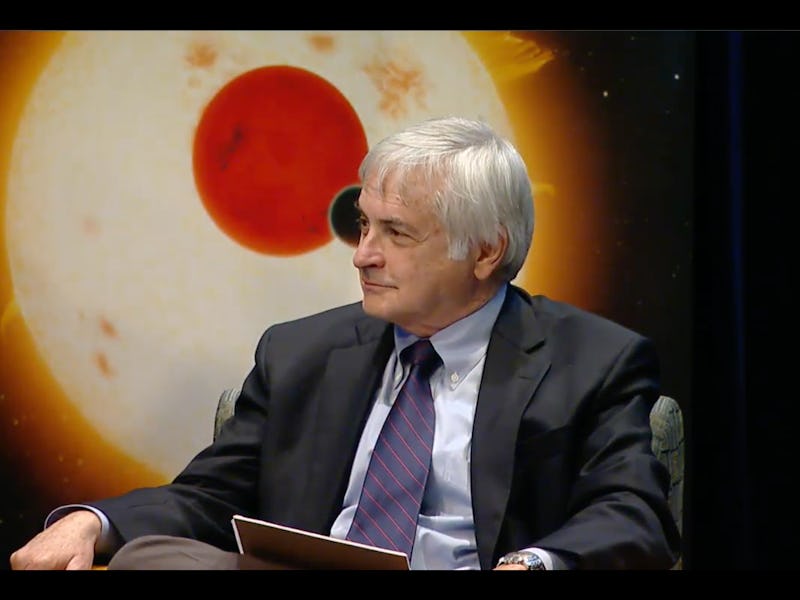The Search for Extraterrestrial Life Puts Astronomers at Odds, Not in Conflict
Researchers can't agree on when we'll find alien life or how we'll find it. But they are talking it out.

Seth Shostak, director for the Center of SETI Research at the SETI Institute, once told an audience he was speaking to that he bet humans would find signs of extraterrestrial life within two-dozen years. At a panel entitled “When Will We Find Life Beyond Earth? hosted by the SETI Institute today, he doubled-down on that bet. Based on what exoplanet researchers have been discovering these days, he explained, “current wisdom is that one in five stars may be a locale for life.” The reasonable conclusions based on reasonable extrapolation? We’re going to find life soon.
But reason sometimes splinters. What was most remarkable out the panel — other than that it was attended by a murderer’s row of astronomical minds — was how much well reasoned disagreement there was. Even the éminence grises of the SETI community, people who have worked together and seem to respect each other, agree on shockingly little. . The event, however, underscored a truth about extraterrestrial, exoplanet, and astrobiology research that isn’t always expressed well to the public: Scientists in the field agree on fact, but not their significance.
Shostak, in case you haven’t already discerned, is avowedly optimistic about the finding extraterrestrials — especially intelligent extraterrestrials. His life’s work is dedicated to listening in for radio signals originating from an intelligent source, and he’s very encouraged by the direction the research is going.
He analogizes SETI research to looking for a needle in a haystack a daunting task, yes, but only if you dont know what you’re. In his mind, there are three major questions: how big is the haystack, how fast we’re able to look through the haystack, and how many needles there are in the damn thing. Shostak thinks we already have answers to the first two — we know relatively how big the universe is and how many stars there are, and we’re able to scan outer space like never before. Our speed at conducting SETI experiments doubles every five years — “and they keep getting faster. We will go through a mission star systems,” within the next two-dozen years, so hes holding tight to his bet.
So the only question is, how many needles are there anyway — i.e. how many alien civilizations are out there?
That’s a question better suited for the the other three panelists. Up next: Fergal Mullally, a scientist working with the Kepler Space Telescope at NASA’s Ames Research Center. Given his role, Mullally is primarily interested in exoplanets. He thinks the data from Kepler has created two major effects.
The first: “In our galaxy, we now know there are more planets than stars out there,” he says. Whereas we previously thought of planets as a rare phenomenon, “we now know [planets] are very common.” And the data shows that an estimated two to 25 percent of those star systems are thought to have an Earth-like planet.
That’s incredible, but lets remember that’s a huge range. Plus, the definition of “Earth-like” encompasses a lot. When scientists use that phrase, they aren’t talking about blue oceans, rolling green hills, and amber waves of grain. They might simply be talking about the bare-bone things that make Earth, well, Earth — liquid water, an atmosphere with some trace amounts of oxygen, a rocky surface, and temperatures that aren’t boiling or causing water to instantly freeze. It’s not a settled science, said Mullally.
Meanwhile, you have Nathalie Cabrol, an astrobiologist and the director for the Carl Sagan Center at the SETI Institute, specializes in an understanding of what we might find in the solar system. And for her, the key potential demographic of alien life is microbes. “You do have to think of life as a continuum,” says Cabrol — and that means remembering that life starts out as primitive, single-celled organisms.
Cabrol may be the most vocal enthusiast about astrobiological research on Mars than any other scientists. “This is the first place where we have started to look at habitability,” said Cabrol. “And were going to start to look for life [there] soon, actually.
Last but not least, the panel feature Mark Showalter, the senior research scientists at the SETI Institute, in the role of skeptic. According to him, life on other planets might be extremely common, or extremely rare. “We don’t know” he said. He emphasizes that it took two billion years to go from single-celled bacterial to multi-cellular humans. And he questions the logic that intelligence is foreordained. When you take into account energy and metabolism, “big brains are not the natural end state of evolution, he said.
Overall, Showalter thinks we need to take into account the mathematical biases that run contrary to the optimism espoused by the other three panelists. In a tongue-in-cheek compromise, he expressed his belief the odds of finding E.T. were 50-50.
Nevertheless, the search for alien life will continue with unbridled excitement. And how could it not? We’re finding more and more exoplanets that look that might be habitable in some capacity. Even private citizens are gearing up to get in on the search, such as in the recent launch of the Breakthrough Starshot initiative.
What’s perhaps most exciting, however, is that we don’t know what might stumble upon. The possibilities are nearly endless. “We are searching for something we don’t know,” Cabrol told the audience Tuesday. And, in a sense, that’s always been true.